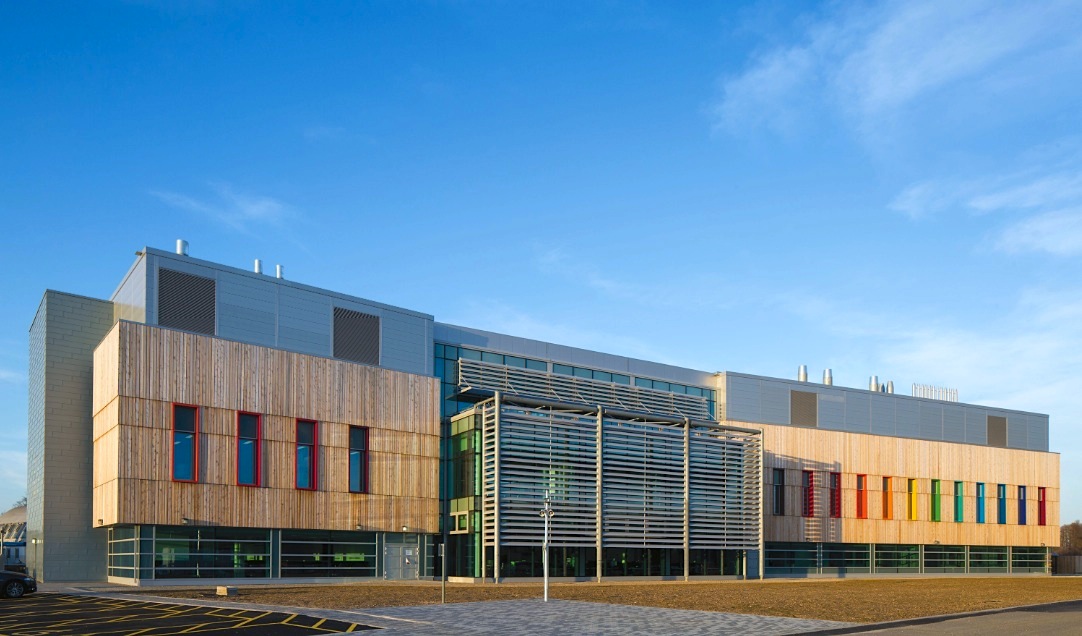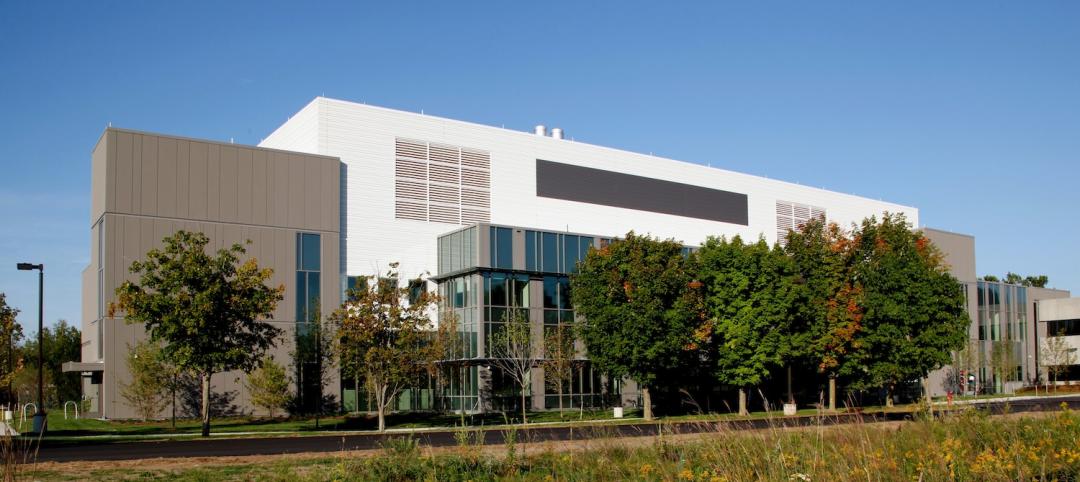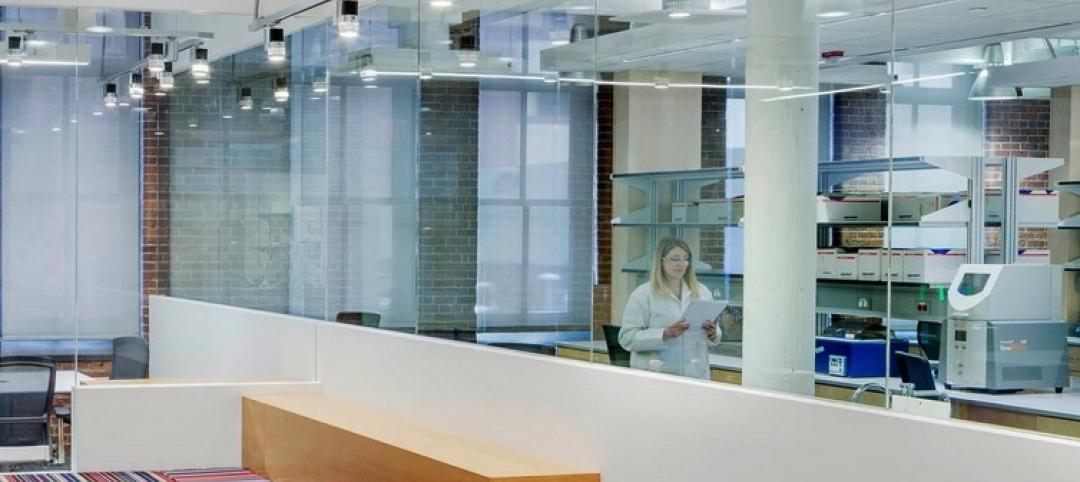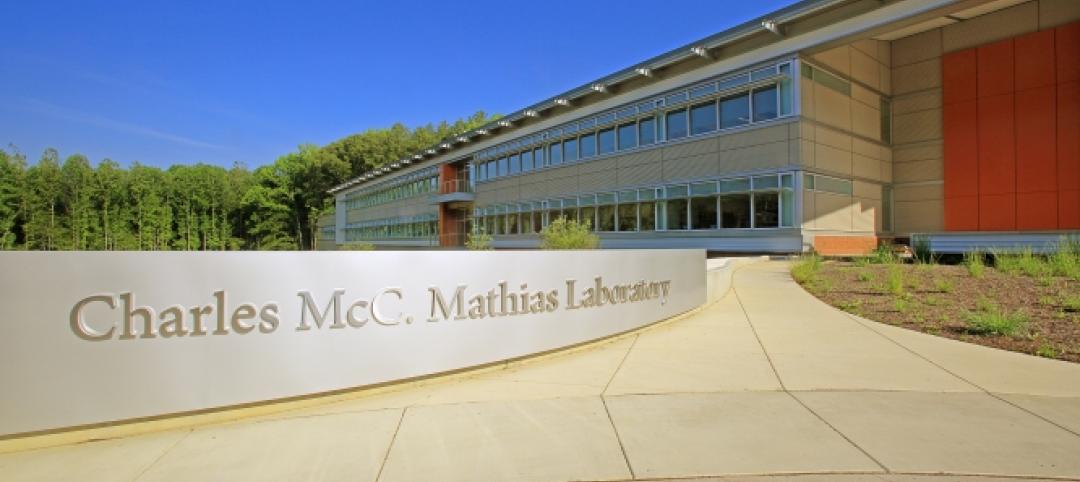In the world of containment facility design, where safety protocols and engineering performance standards ultimately trump all other programmatic considerations, government agencies and research institutions have applied the same basic formula when planning their most sensitive facilities: build a box within a box and establish a series of strict safety protocols to ensure that any nefarious agents can’t get out—or in.
This bunker-like, box-in-box approach has been the template for decades—it just works. But is it truly the most efficient and effective way to conduct research? Does it offer a workplace that inspires its researchers and scientists to do better work? Does it foster the level of collaboration that today’s leading research institutions are pushing for? Does it help attract and retain the most talented researchers?
These are the questions that the leadership team at the Pirbright Institute—the world’s leading research agency in the study of foot and mouth disease and other viral diseases of livestock—pondered when planning its new Category 4 biocontainment facility (roughly equivalent to BSL-3 Enhanced standards in the U.S.) in the countryside of Surrey, England.
Formerly housed in a series of outdated, uninspired buildings spread throughout the campus in Surrey, Pirbright’s containment labs were inadequate and lacked the level of environmental control required for cutting-edge research. The institute looked to consolidate its facilities into a flagship building. Pirbright wanted to rewrite the formula for containment lab design by creating a facility that would be truly open, with daylight and views for everyone in the building (even those working in the most stringent containment zones), highly collaborative workspaces, areas of respite, and spaces for all-staff symposiums and meetings. Most importantly, the Biotechnology and Biological Sciences Research Council (BBSRC), as the strategic investor in the Pirbright Institute, wanted a lab that would breed new, inspirational science by bringing its researchers closer together.
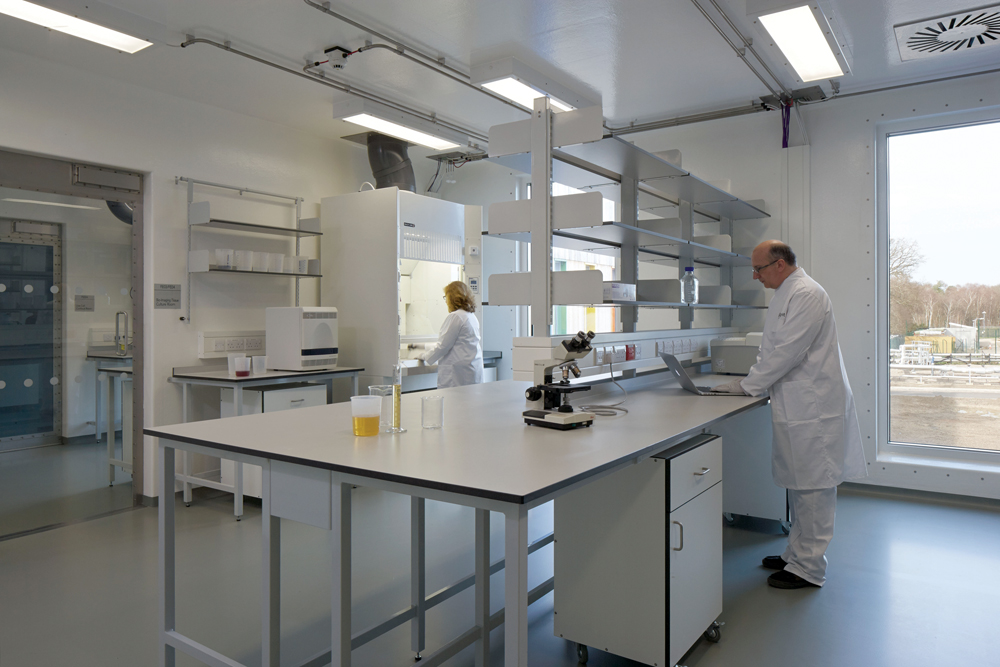 Floor-to-ceiling windows flood the high-containment labs with natural light and offer scenic views of the Pirbright Institute campus. Extensive use of interior glass throughout the facility brings daylight further into the interior and creates a sense of connectivity among the spaces. Photo: © James Brittain, courtesy HDR Architecture
Floor-to-ceiling windows flood the high-containment labs with natural light and offer scenic views of the Pirbright Institute campus. Extensive use of interior glass throughout the facility brings daylight further into the interior and creates a sense of connectivity among the spaces. Photo: © James Brittain, courtesy HDR Architecture
“Ultimately, I want to be able to say that I was involved in creating a building that led to the discovery of a breakthrough vaccine or a new approach to science,” says Alex Hewitson, Program Director and Head of Campus Delivery Program with BBSRC, the quasi-governmental agency that manages and funds the Pirbright Institute, along with seven other research groups across the U.K.
“Scientists have real down time, and they need this time to talk to other scientists,” says Hewitson. “We wanted a containment facility where scientists could come together in areas of research that currently lie untapped or unthought of.”
The institution needed a world-class Building Team that could execute its audacious plan. AECOM was brought on board as the project manager for the team: HDR (design architect/lab planner), Shepherd Group (design-builder), AECOM Engineering (SE/MEP engineer), Turner and Townsend (cost consultant), and Merrick & Co. (validation and commissioning consultant).
TURNING BIOCONTAINMENT INSIDE OUT
The design team’s radical plan for the 150,000-sf biocontainment facility—officially called the BBSRC National Virology Centre Plowright Building—centers on the basic idea of humanizing science. The scheme literally turns the typical containment lab building inside out. Work and collaboration zones—offices, conference rooms, and cafeteria—are at the center of the building; the high-level containment labs are at the perimeter. The lion’s share of work and meeting spaces is located within the containment zones, including a portion of the main cafeteria. This configuration greatly reduces the number of times researchers must transfer in and out of containment in a typical workday.
“When the researchers change out of their street clothes and gown-in each morning, they can do anything they need to do without having to leave the containment area—they no longer have to go back and forth 10 to 12 times a day,” says Brian Kowalchuk, AIA, LEED AP, Director of Design with HDR. “They’re required to shower out for five minutes at a time, so it’s a fairly robust and time-consuming routine to go in and out of containment. They’re saving a ton of time with the new facility, fostering a more productive environment.”
A dramatic, three-story, skylit glass atrium at the heart of the building—a feature virtually unheard of in containment facility design—offers views into the containment areas that surround the space. The building’s glass curtain wall, skylit atrium, and abundant interior glass flood the interior spaces with natural light and provide scenic views of the campus, as well as visual connectivity to the work occurring inside the building.
“This is the first time a modern, high-containment lab has been designed with external windows directly into the containment areas,” says Mark Halstead, Project Management Director and Head of Science and Innovation with AECOM. “Every lab has full-height windows. Compare that to the traditional containment facility, where many containment areas don’t have windows at all.”
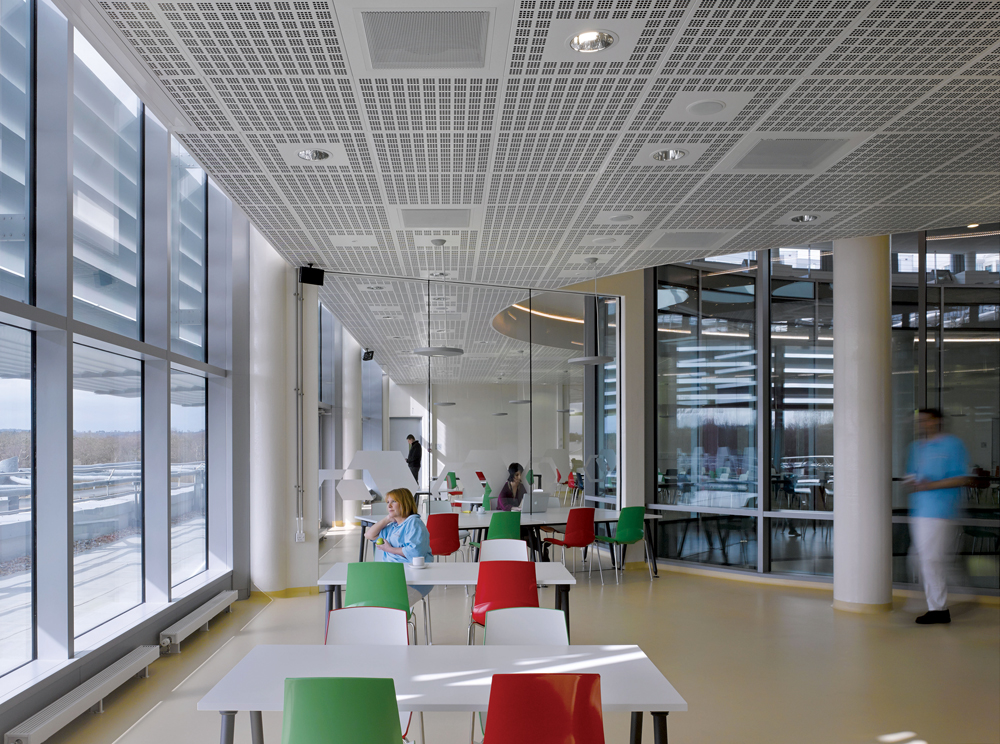 The second floor houses a cafeteria, called the “canteen,” which offers seating both within and outside the containment barrier. A 15-foot-high glass wall divides the room, yet permits a visual connection between the two dining spaces. It also allows Pirbright to hold all-staff meetings and symposiums without requiring researchers to leave containment. Photo: © James Brittain, courtesy HDR Architecture
The second floor houses a cafeteria, called the “canteen,” which offers seating both within and outside the containment barrier. A 15-foot-high glass wall divides the room, yet permits a visual connection between the two dining spaces. It also allows Pirbright to hold all-staff meetings and symposiums without requiring researchers to leave containment. Photo: © James Brittain, courtesy HDR Architecture
Transparency and daylight—along with lively design details like a helical staircase off the atrium and splashes of color throughout the interior—combine to create a sense of informality and well-being in a facility where potentially life-threatening research work is being conducted. Visual and physical barriers typical of a containment facility are broken down. The most striking examples are the atrium and the second-floor cafeteria, called the “canteen,” where a 15-foot-high glass wall is all that separates the containment dining area from the general eating area.
“For the first time, Pirbright will be able to host all-staff meetings and symposiums on site in these dramatic spaces at the center of the building—without researchers having to leave containment,” says Kowalchuk. “They can take lunch, attend a conference, sit down to write their lab notes, hold a meeting, talk on their cell phones—all within containment.”
Kowalchuk likens the building’s containment strategy to peeling an onion. In meeting the U.K.’s stringent SAPO (Specified Animal Pathogen Order) level 4 containment standards, the team applied a layered approach, based on the risk level—RS0 to RS4—of a given space in the facility. The design mirrors the level of risk with this layered approach.
“Researchers start at the center of the building, where the collaborative spaces in non-containment or RS0 are located, and work toward the outside of the facility, where the highest-risk spaces are located,” says Kowalchuk. “Transitioning from one risk level to another does not necessarily require staff to shower in or out—it may call for simply changing shoes or removing gloves and gowns.”
The building is engineered with a negative-pressure air cascade that flows from the least risky to the most risky zones to ensure that no infectious virus could get out. All air is filtered through HEPA filters. Non-solid waste is processed through an in-house effluent plant; solid waste is autoclaved or passed through a fumigation lobby, greatly minimizing the risk of viruses escaping the facility.
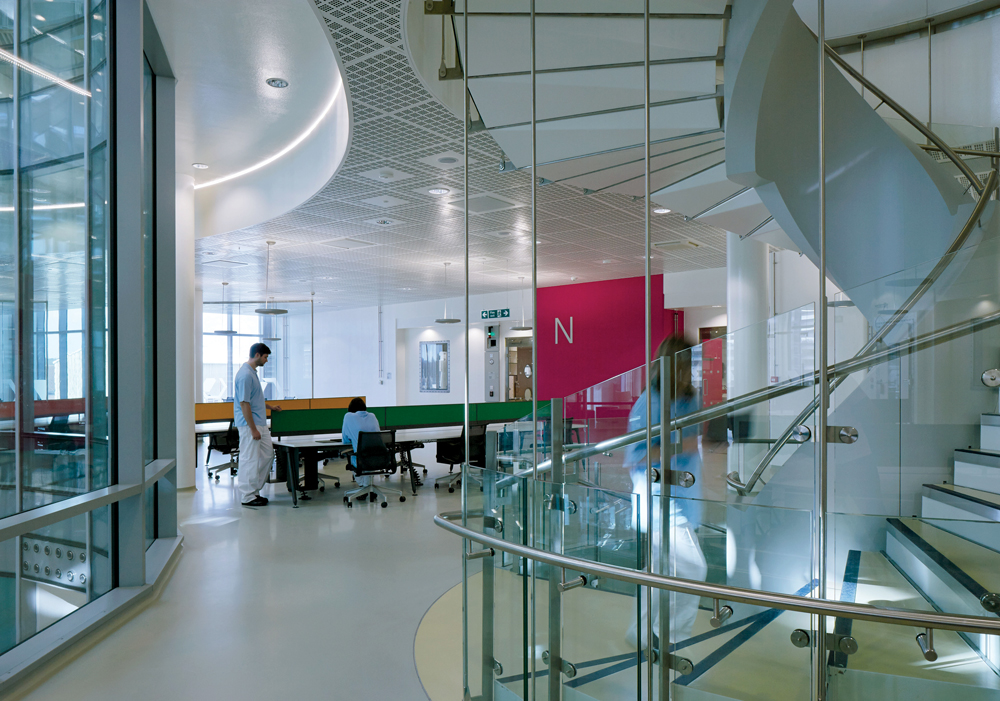 All collaboration spaces are located within the containment barrier surrounding the oval-shaped atrium. Conference rooms and a shared computer lab are on the ground floor; unassigned write-up space and conference rooms on the first floor; and the cafeteria and outdoor patio on the top floor. A helical staircase connects these central collaboration spaces. Containment areas within the atrium are accessible to all researchers in the facility, fostering cross-disciplinary interaction. Photo: © James Brittain, courtesy HDR Architecture
All collaboration spaces are located within the containment barrier surrounding the oval-shaped atrium. Conference rooms and a shared computer lab are on the ground floor; unassigned write-up space and conference rooms on the first floor; and the cafeteria and outdoor patio on the top floor. A helical staircase connects these central collaboration spaces. Containment areas within the atrium are accessible to all researchers in the facility, fostering cross-disciplinary interaction. Photo: © James Brittain, courtesy HDR Architecture
The design themes of informality and humanizing science are further reflected in the building’s exterior scheme. The lab wings are clad in Siberian larch timber articulated by punched windows with colorful surrounds. The timber cladding helps to break the façade into more pleasing proportions and incorporates the rooftop mechanical space running the length of the building. A metal brise soleil divides the south-facing façade. On the opposite side, the facility’s main entrance is adorned with a timber-framed, glass-roof canopy, providing a warm, inviting design element to greet staff and visitors.
MASTERING THE CONSTRUCTION DETAILS
HDR’s game-changing design posed a slew of thorny issues for the team, necessitating new building details specific to this project to be designed and tested by the architects, engineers, and constructors. The construction team, led by Shepherd Group Construction Director David Crampton, needed to:
• Develop a durable containment barrier that could deliver very low air leakage rates—a task made infinitely more difficult given the copious amount of perimeter glass.
• Meet ultra-tight construction tolerance requirements for the 2,182 stainless steel frames cast into the concrete frame to allow services, windows, and doors to pass through the containment barrier.
• Achieve stringent air leakage standards (0.0091 per m3/m2/hr at 200 pascal, both positive and negative pressure) throughout the contained labs.
• Design and install a robust mechanical and electrical system with controls that had the resilience to maintain containment under failure conditions.
The Building Team invested $1.5 million—roughly 1% of the project budget—to construct a fully functioning, two-story, 1,600-sf mockup of a typical three-person lab unit. There, the team tested nearly every component of the building—from the seven-layer containment coating for the concrete walls, to the performance of the low-air-leakage-rated doors, to the fastening system for the lab benching, to the mechanical systems.
What Pirbright’s Scientists Are Saying About Their New Lab
“The new facility is generating excitement worldwide, and has significantly improved Pirbright’s ability to recruit the very best virology researchers. In 2008, only 105 people worked at Pirbright, and it was difficult to get new people on board. After the funding was approved, the attitude changed, and there are currently 350 people employed at Pirbright.”
—Michael Johnson, PhD, Head of Laboratory, Head of Engineering and Estates
“The new facility provides such a nice working environment, and we’re able to see each other—all in one building.”
—Chris Sanders, PhD, Insectary, Entomology and Transmission Biology
“To me, the success of this building lies in the plethora of natural light, even in the corridors. This is unheard of in a biocontainment facility.”
—Don King, PhD, Foot-and-Mouth Disease World Reference Laboratory
“This was more than your typical mockup,” says Crampton. “It was a true R&D facility built by the subcontractors who ultimately would build the lab facility. A secret to this project’s success has to do with the research and understanding about what’s being built and how you’re going to put things together.”
Using the mockup, the team was able to perfect a gasket system for the through-wall penetrations. It involved casting stainless steel frames into the concrete wall at each of the 2,182 penetration points. Penetration elements—windows, doors, service ducts—were then bolted to the frame with a neoprene gasket.
This approach provided a solution that meets the stringent air leakage performance standards and can be easily serviced and maintained over the building’s lifespan. “If a window breaks or they need to get at a maintenance point to perform service work, they can reinsert a gasket and achieve the leakage rate again,” says Crampton. “We’re not dependent in any way on silicon mastics, which deteriorate over time, for the seal. This approach is repeatable, replaceable, and maintainable.”
Other quality control and performance management procedures included:
Factory acceptance testing. Manufacturers of major equipment and systems, such as boilers, chillers, generators, treatment plants, and autoclaves, were sent test packs and were asked to perform specific tests of their equipment for the Pirbright team. “All too often, equipment does not work properly,” says Crampton. “We wanted to be sure that when a piece of equipment arrived on site, it could be plugged in and it would work. This allowed us to move into commissioning with verified equipment performance, greatly reducing the risk to this phase of the work and the subsequent activities leading to validation and licensing.”
Site-specific quality measures. Nine signatures were required before concrete could be poured on the site, including sign-offs from the mechanical and electrical subcontractors, who were tasked with double-checking the accuracy of MEP service penetrations. “We also developed pretty extensive management systems for the crimped pipework,” says Crampton. “We were able to identify the individuals who worked on every pipe joint in the building. That way if there was an issue, we could go back and inspect all the joints that individual worked on.”
Clean builder procedure. In an unusual move—but one that all Building Team members agree was vital to the success of the project—Crampton instituted a “clean builder procedure” for the job site. Before setting foot on the site, workers were required to change into all-white uniforms—overalls, boots, gloves, hard hats—and don a “TEAM PIRBRIGHT” badge. This lab-like approach to construction operations reinforced the critical importance of the scientific work that would be performed there. “We tried to create a village-like culture,” says Crampton. “We provided a well-lit, warm, inviting environment to work in and first-class restaurant facilities on the site.” They even organized activities like soccer tournaments.
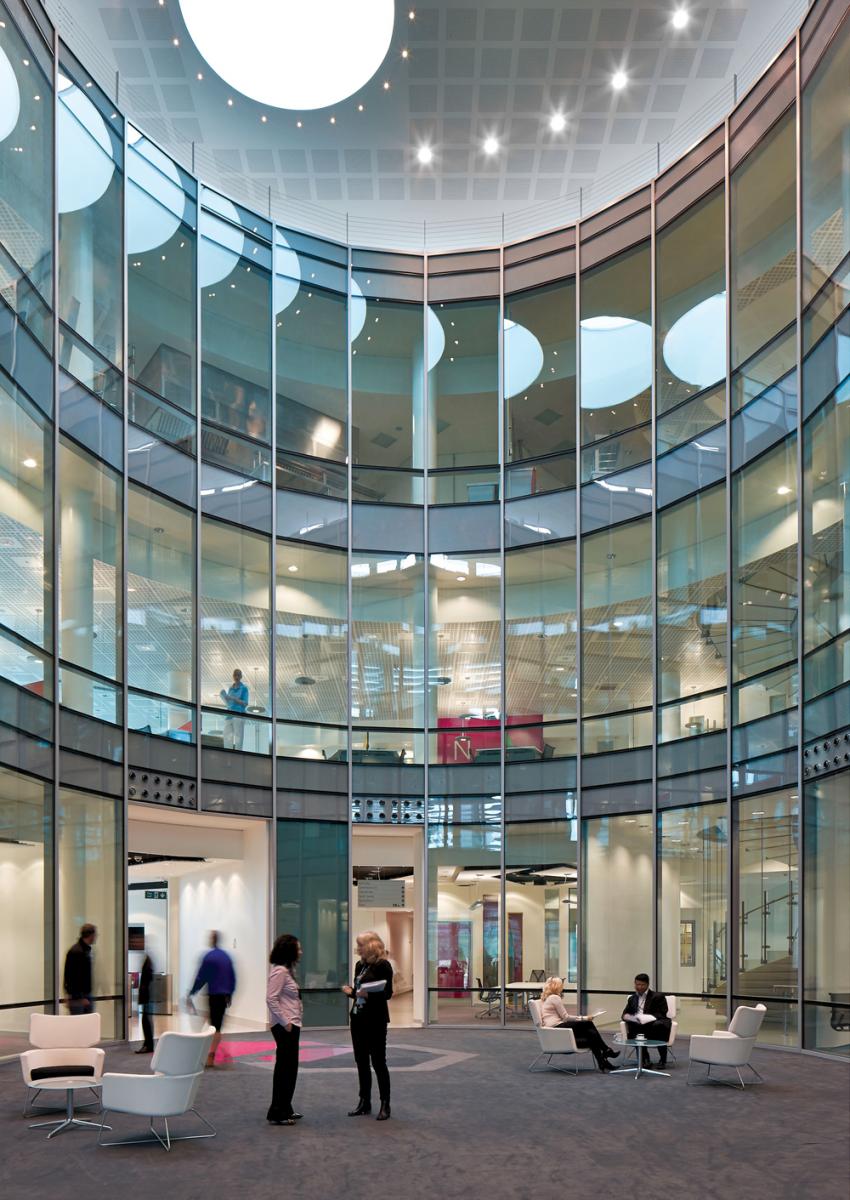 A three-story, skylit glass atrium—virtually unheard of in containment facility design—serves as the heart of the building. All collaboration spaces are located within the containment barrier surrounding the oval-shaped atrium. Photo: © James Brittain, courtesy HDR Architecture
A three-story, skylit glass atrium—virtually unheard of in containment facility design—serves as the heart of the building. All collaboration spaces are located within the containment barrier surrounding the oval-shaped atrium. Photo: © James Brittain, courtesy HDR Architecture
Building Team scoring and 360-degree feedback. All team members were scored regularly by their peers based on hard and soft key performance indicators, including communication, collaboration, risk management, quality of service, and quality of product. A third party collected the scores and presented the results at twice-monthly meetings.
AECOM’s Halstead says it’s not unusual for U.K. construction projects to collect KPI scores for hard-performance indicators, like schedule or cost deviation. “We took it a step further and measured softer points around team interaction, collaboration, and the degree of innovation in arriving at design solutions and overcoming challenges,” he says. This approach kept the team accountable, focused, and united.
Halstead says these quality and performance protocols paid off. “Of the 2,182 penetrations that had to be cast into the concrete containment barrier, all but six were in the precise location,” he says. “You don’t achieve a 99.9% level of accuracy without having a great team culture and the right systems and procedures in place.”
‘THE BEST CONTAINMENT FACILITY IN THE WORLD’
Following more than a decade of planning and nearly four years of construction, the BBSRC National Virology Centre Plowright Building opened its doors to eager scientists on October 31. The Building Team delivered the game-changing facility under budget and a week early—no small feat, given the complexity and size of the project.
Hewitson says early feedback from the Pirbright staff has been positive. “Many who were skeptical initially are now endorsing the project,” he says. “Our researchers lived through years where the business of construction overshadowed the science, but now they can say Pirbright lays claim to the best containment facility in the world.”
5 Ways Pirbright’s New Facility Advances Containment Lab Design
1. “Inside-out” layout flips the typical box-in-box containment facility, placing the collaboration, writeup, and dining spaces at the center of the building, and the labs along the perimeter.
2. Extensive use of exterior and interior glass floods the interior spaces with daylight—even in the most secure labs—and provides scenic views of the campus, as well as visual connectivity to the work occurring within the heart of the building.
3. Offices, conference rooms, dining areas, and respite spaces are located within the containment zones, minimizing the number of showers researchers must take every day.
4. Layered approach to containment protocol simplifies the procedures for entering and leaving containment zones.
5. Warm materials, lively design elements, and splashes of color humanize the spaces and create a bold, almost nonscientific aesthetic.
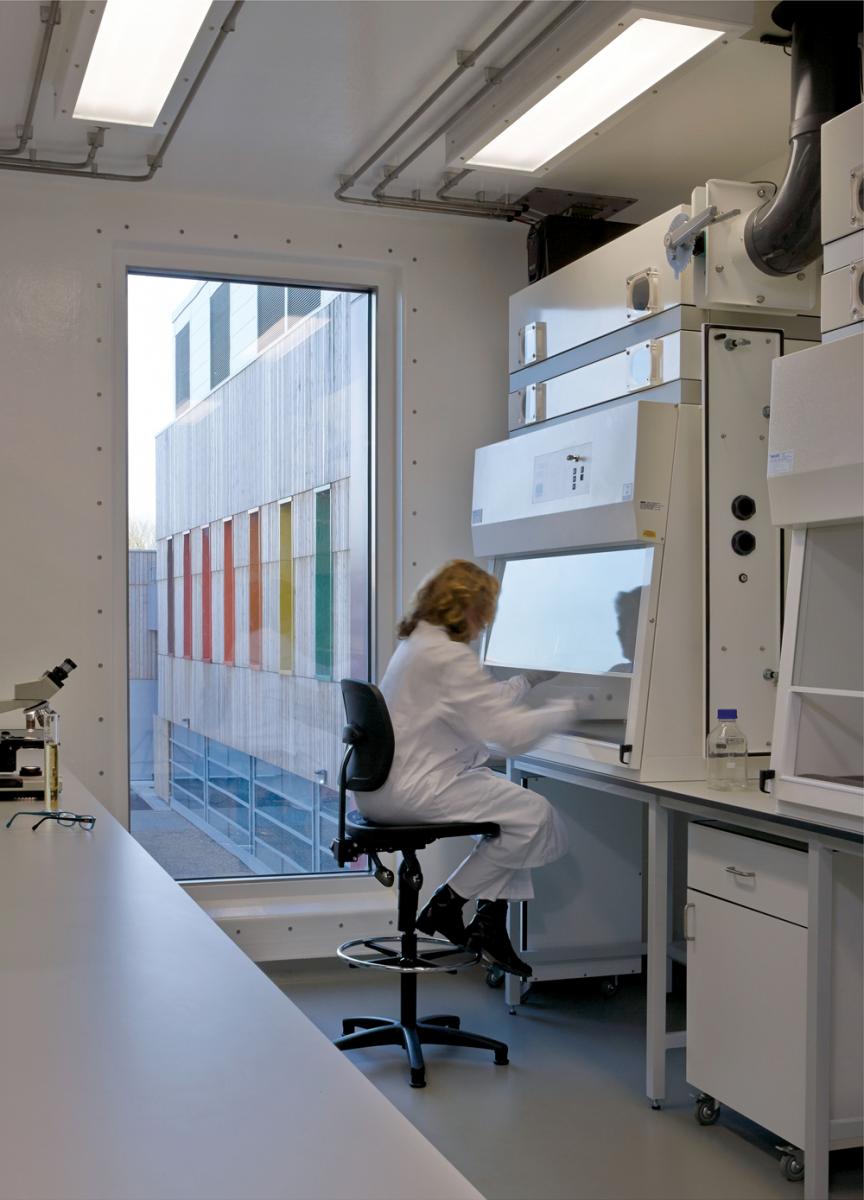 “At Pirbright, researchers are working in high containment for up to ten hours a day,” says Mark Bryan, HDR’s Principal Laboratory Planner on the project. “This new facility provides similar services and degree of comfort for everyone in the building, including those in high containment.” Photo: © James Brittain, courtesy HDR Architecture
“At Pirbright, researchers are working in high containment for up to ten hours a day,” says Mark Bryan, HDR’s Principal Laboratory Planner on the project. “This new facility provides similar services and degree of comfort for everyone in the building, including those in high containment.” Photo: © James Brittain, courtesy HDR Architecture
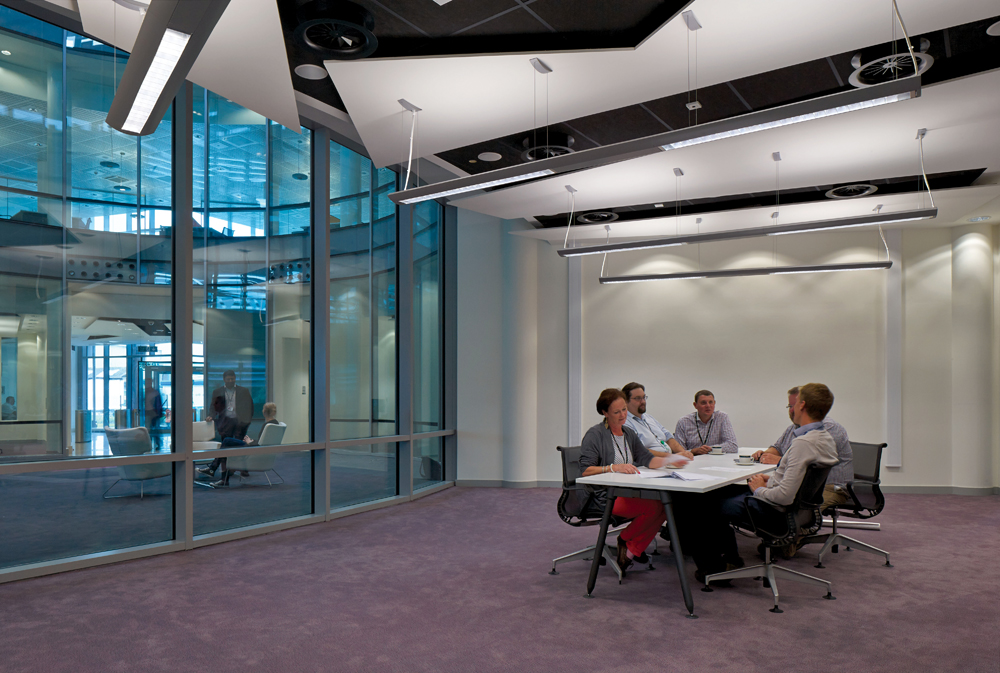 Conference rooms and a shared computer lab are on the ground floor. Photo: © James Brittain, courtesy HDR Architecture
Conference rooms and a shared computer lab are on the ground floor. Photo: © James Brittain, courtesy HDR Architecture
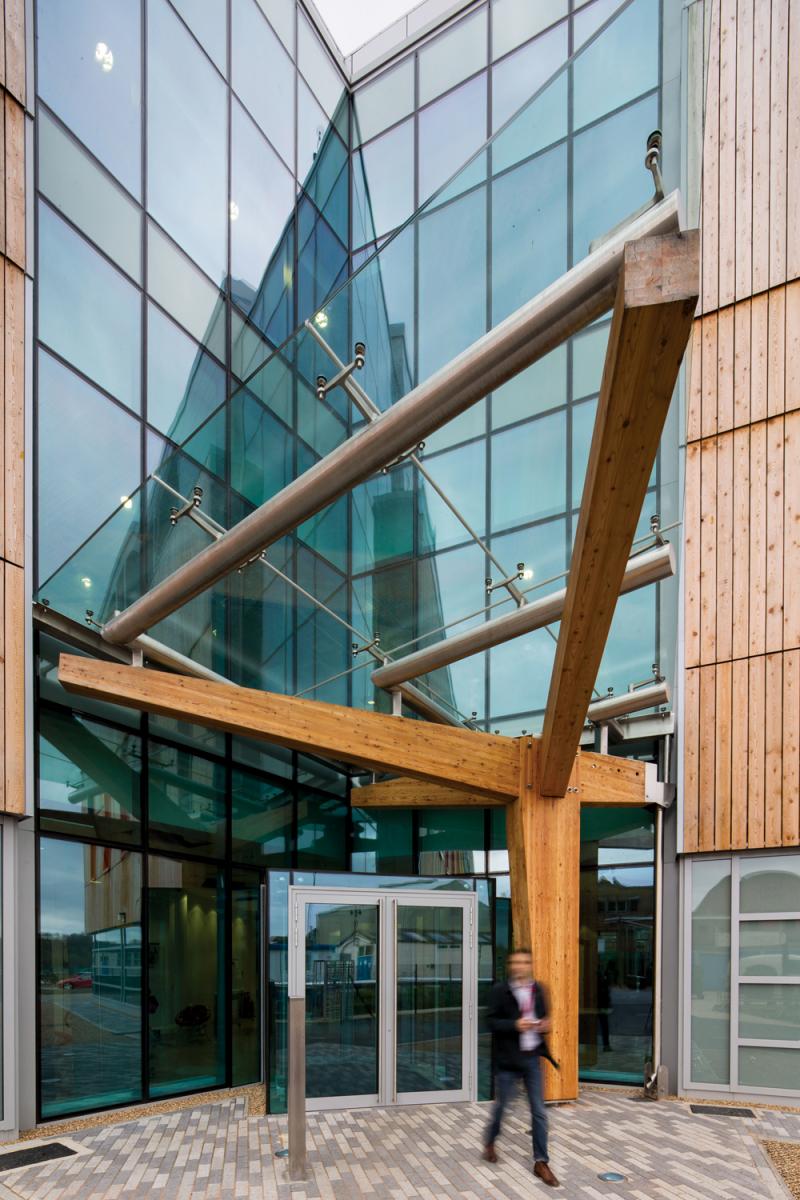 The facility’s main entrance is adorned with a timber-framed, glass-roof canopy, providing a warm, inviting design element to greet staff and visitors. Photo: © Dan Schwalm, courtesy HDR Architecture
The facility’s main entrance is adorned with a timber-framed, glass-roof canopy, providing a warm, inviting design element to greet staff and visitors. Photo: © Dan Schwalm, courtesy HDR Architecture
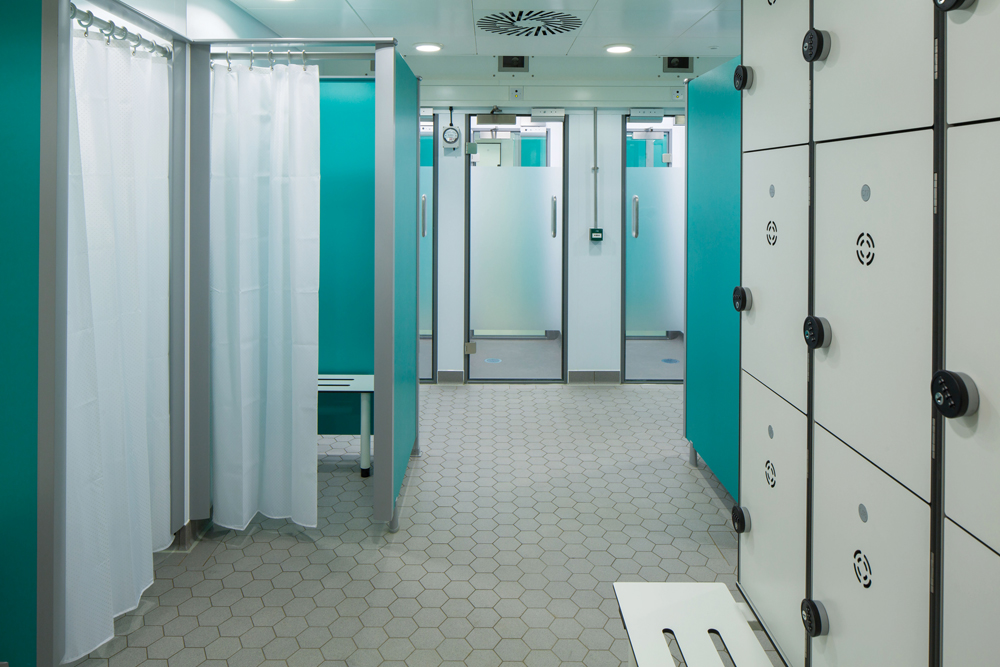 Researchers enter the containment areas through a locker room outside of containment, where they store their street clothes, shoes, and accessories (only eyeglasses are permitted) and change into sterilized undergarments, scrubs, socks, and shoes. To get into the labs, researchers walk into an ante-room air lock. They are required to put on a lab coat over their scrubs, take off their shoes, and “step over” into a clean pair. Researchers leave the containment zone by retracing their steps back through the locker and shower rooms, where they remove their clothes, disinfect their glasses, and then shower for five minutes (red light/green light indicates when shower time minimum is reached), before dressing in their street clothes. Photo: © Dan Schwalm, courtesy HDR Architecture
Researchers enter the containment areas through a locker room outside of containment, where they store their street clothes, shoes, and accessories (only eyeglasses are permitted) and change into sterilized undergarments, scrubs, socks, and shoes. To get into the labs, researchers walk into an ante-room air lock. They are required to put on a lab coat over their scrubs, take off their shoes, and “step over” into a clean pair. Researchers leave the containment zone by retracing their steps back through the locker and shower rooms, where they remove their clothes, disinfect their glasses, and then shower for five minutes (red light/green light indicates when shower time minimum is reached), before dressing in their street clothes. Photo: © Dan Schwalm, courtesy HDR Architecture
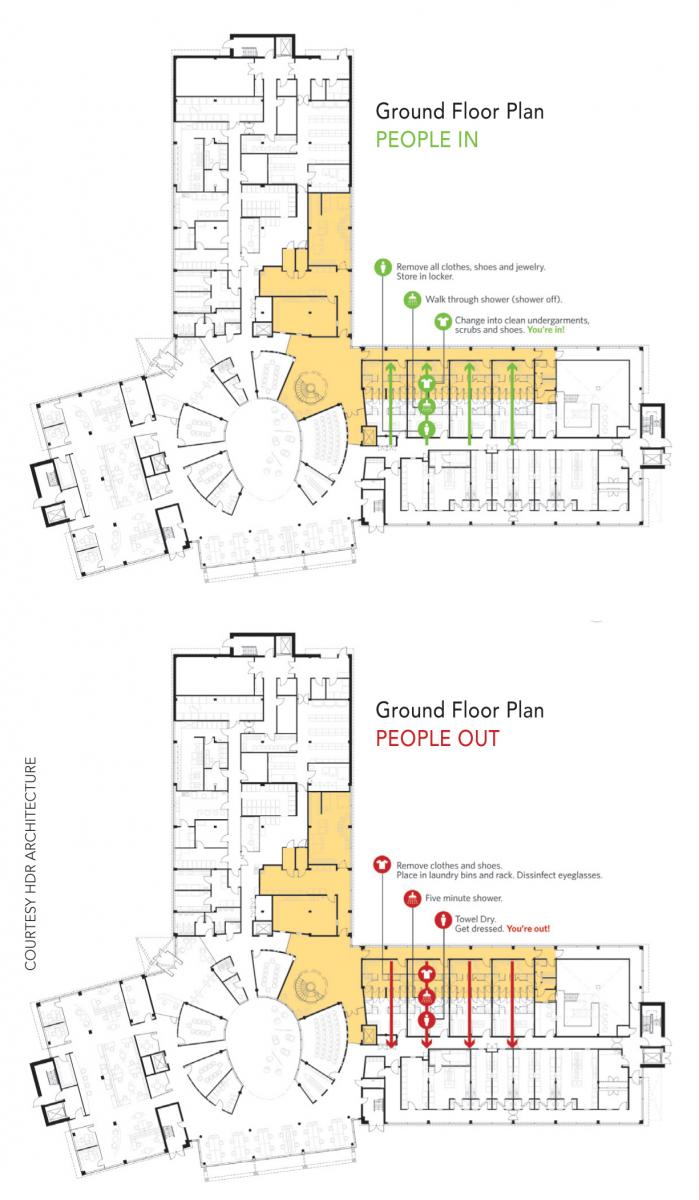
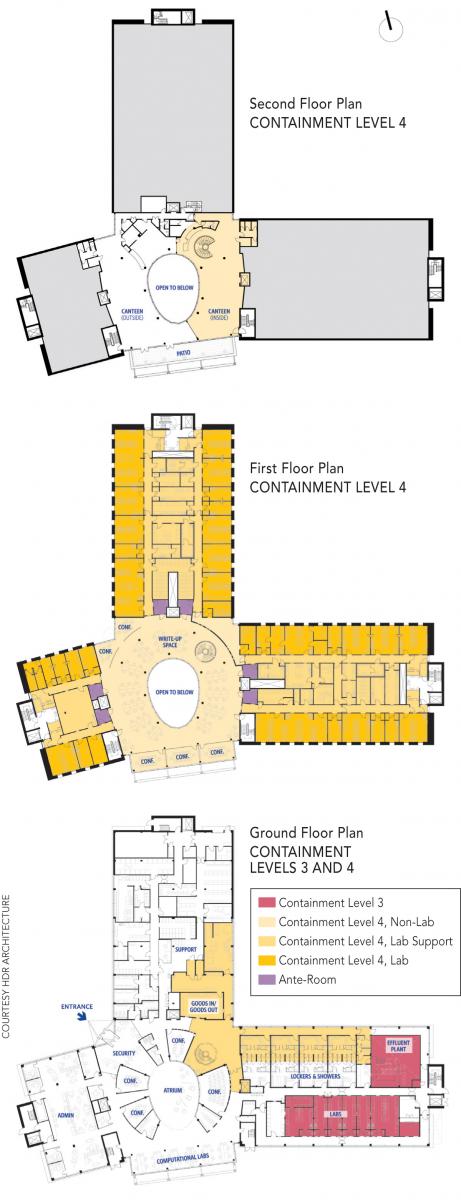
PROJECT SUMMARY
BBSRC National Virology Centre
Plowright Building
Surrey, England
Building Team
Owner: Pirbright Institute, Biotechnology and Biological Sciences Research Council
Architect, lab planner: HDR
Project manager: AECOM
Structural, MEP engineer: AECOM Engineering
Cost consultant: Turner and Townsend
Commissioning consultant: Merrick & Co.
Design-builder: Shepherd Group
General Information
Size: 151,000 sf
Construction cost: $175 million U.S.
Construction time: July 2011 to October 2014
Delivery method: Design-build lump sum price
Containment level: Category 4 (roughly equivalent to BSL-3 Enhanced)
Related Stories
| Nov 17, 2014
A new BSL-3 public-safety lab debuts in Vermont
The laboratory will be used to perform a wide range of analyses to detect biological, toxicological, chemical, and radiological threats to the health of the population, from testing for rabies, West Nile, pertussis and salmonella to water and food contaminants.
| Nov 4, 2014
HOK breaks ground on colossal research complex for LG in Seoul
Located in Seoul’s Magok District, the LG Science Park provides facilities to support innovative research and industrial prototyping. HOK designed phase one of the master plan and six of the laboratory and office buildings.
| Oct 16, 2014
Perkins+Will white paper examines alternatives to flame retardant building materials
The white paper includes a list of 193 flame retardants, including 29 discovered in building and household products, 50 found in the indoor environment, and 33 in human blood, milk, and tissues.
| Oct 15, 2014
Harvard launches ‘design-centric’ center for green buildings and cities
The impetus behind Harvard's Center for Green Buildings and Cities is what the design school’s dean, Mohsen Mostafavi, describes as a “rapidly urbanizing global economy,” in which cities are building new structures “on a massive scale.”
| Oct 12, 2014
AIA 2030 commitment: Five years on, are we any closer to net-zero?
This year marks the fifth anniversary of the American Institute of Architects’ effort to have architecture firms voluntarily pledge net-zero energy design for all their buildings by 2030.
| Oct 9, 2014
Beyond the bench: Meet the modern laboratory facility
Like office workers escaping from the perceived confines of cubicles, today’s scientists have been freed from the trappings of the typical lab bench, writes Perkins+Will's Bill Harris.
| Sep 24, 2014
Architecture billings see continued strength, led by institutional sector
On the heels of recording its strongest pace of growth since 2007, there continues to be an increasing level of demand for design services signaled in the latest Architecture Billings Index.
| Sep 22, 2014
4 keys to effective post-occupancy evaluations
Perkins+Will's Janice Barnes covers the four steps that designers should take to create POEs that provide design direction and measure design effectiveness.
| Sep 22, 2014
Sound selections: 12 great choices for ceilings and acoustical walls
From metal mesh panels to concealed-suspension ceilings, here's our roundup of the latest acoustical ceiling and wall products.
| Sep 19, 2014
Smithsonian Institution opens LEED Platinum lab facility
The Charles McC. Mathias Laboratory will emit 37% less CO2 than a comparable lab that does not meet LEED-certification standards.


